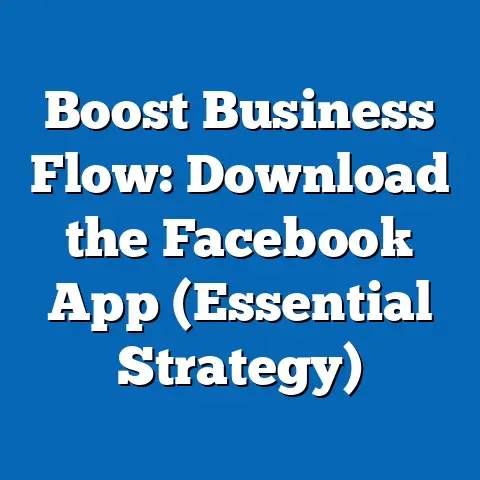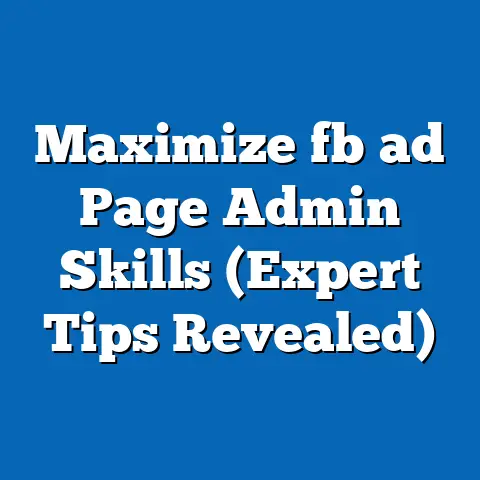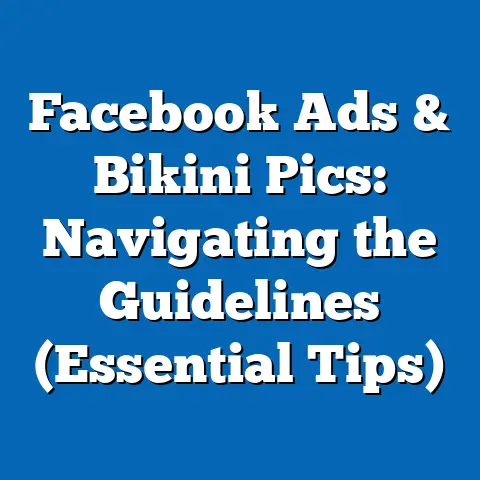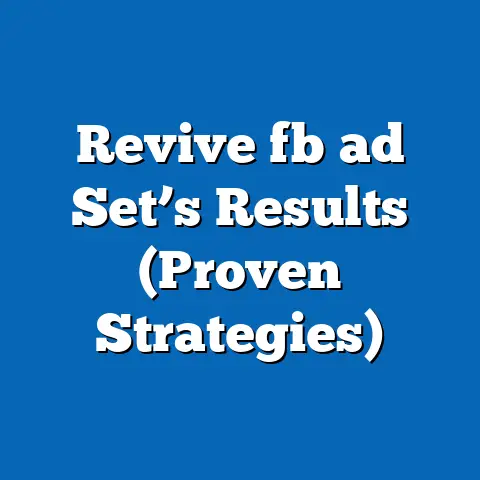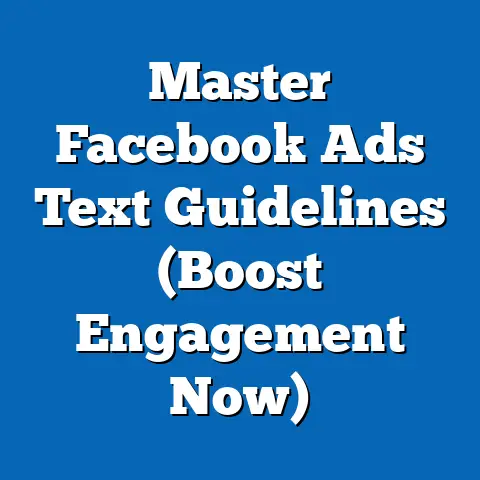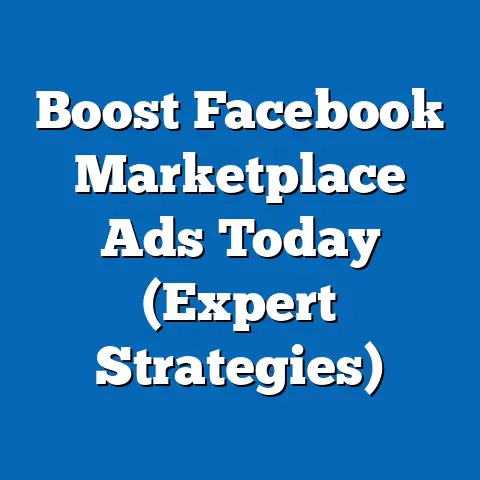Unlock the Best Facebook Ad Types (Proven Strategies Revealed)
Did you know that Facebook reaches over 2.9 billion people every month? That’s a staggering number, and it represents a massive opportunity for businesses to connect with their target audience. But simply throwing ads at the wall and hoping something sticks isn’t a viable strategy. To truly tap into Facebook’s potential, you need to understand the different ad types available and how to use them effectively.
I’ve spent years navigating the ever-changing landscape of Facebook advertising, and I’ve seen firsthand what works and what doesn’t. From launching small campaigns for local businesses to managing large-scale projects for international brands, I’ve learned that the key to success lies in choosing the right ad type for your specific goals and audience.
Understanding Facebook Ad Types
Facebook offers a diverse range of ad types, each designed to cater to different marketing objectives and target audiences. Choosing the right ad type is crucial for maximizing your campaign’s effectiveness and achieving your desired outcomes. Let’s explore the most common Facebook ad types:
-
Image Ads: These are the simplest and most common type of Facebook ad. They consist of a single image, accompanied by text and a call-to-action button. Image ads are ideal for brand awareness campaigns and showcasing products with visually appealing imagery.
-
Video Ads: Video ads are incredibly engaging and can be used to tell stories, demonstrate products, or share testimonials. They’re perfect for capturing attention and conveying complex messages in a dynamic and memorable way.
-
Carousel Ads: Carousel ads allow you to display multiple images or videos in a single ad unit. Users can swipe through the carousel to view different products, features, or aspects of your brand. This ad type is excellent for showcasing a range of offerings or telling a sequential story.
-
Slideshow Ads: Slideshow ads are similar to video ads, but they’re created using a series of static images. They’re a great option for businesses with limited video production resources or for reaching audiences with slower internet connections.
-
Collection Ads: Collection ads are designed for e-commerce businesses and allow you to showcase a catalog of products in a visually appealing format. They typically feature a hero image or video, followed by a selection of related products.
Image Ads: These are the simplest and most common type of Facebook ad. They consist of a single image, accompanied by text and a call-to-action button. Image ads are ideal for brand awareness campaigns and showcasing products with visually appealing imagery.
Video Ads: Video ads are incredibly engaging and can be used to tell stories, demonstrate products, or share testimonials. They’re perfect for capturing attention and conveying complex messages in a dynamic and memorable way.
Carousel Ads: Carousel ads allow you to display multiple images or videos in a single ad unit. Users can swipe through the carousel to view different products, features, or aspects of your brand. This ad type is excellent for showcasing a range of offerings or telling a sequential story.
Slideshow Ads: Slideshow ads are similar to video ads, but they’re created using a series of static images. They’re a great option for businesses with limited video production resources or for reaching audiences with slower internet connections.
Collection Ads: Collection ads are designed for e-commerce businesses and allow you to showcase a catalog of products in a visually appealing format. They typically feature a hero image or video, followed by a selection of related products.
To help you visualize these ad types, imagine scrolling through your own Facebook feed. You’ll likely encounter image ads promoting sales, video ads sharing inspiring stories, carousel ads showcasing new product lines, slideshow ads highlighting travel destinations, and collection ads featuring curated selections from online stores.
Key Takeaway: Understanding the different Facebook ad types is the first step towards creating effective campaigns. Each ad type has its own strengths and is best suited for specific marketing objectives.
Proven Strategies for Each Ad Type
Now that we’ve covered the different Facebook ad types, let’s delve into proven strategies for maximizing their effectiveness. These strategies are based on my own experience and insights, as well as industry best practices.
Image Ads: Simplicity and Impact
Image ads are a staple of Facebook advertising, and for good reason. They’re easy to create, relatively inexpensive, and can be highly effective when done right. Here are some key strategies for optimizing your image ads:
-
High-Quality Images: This is non-negotiable. Your image should be visually appealing, well-lit, and relevant to your product or service. Avoid blurry or pixelated images, as they can damage your brand’s credibility.
-
Clear Branding: Ensure your brand logo and colors are prominently displayed in the image. This helps build brand recognition and reinforces your brand identity.
-
Concise Copy: Keep your ad copy short and sweet. Focus on highlighting the key benefits of your product or service and use a strong call to action.
-
A/B Testing: Experiment with different images and ad copy to see what resonates best with your target audience.
High-Quality Images: This is non-negotiable. Your image should be visually appealing, well-lit, and relevant to your product or service. Avoid blurry or pixelated images, as they can damage your brand’s credibility.
Clear Branding: Ensure your brand logo and colors are prominently displayed in the image. This helps build brand recognition and reinforces your brand identity.
Concise Copy: Keep your ad copy short and sweet. Focus on highlighting the key benefits of your product or service and use a strong call to action.
A/B Testing: Experiment with different images and ad copy to see what resonates best with your target audience.
I once worked with a local coffee shop that was struggling to attract new customers. We decided to run an image ad featuring a stunning photo of their signature latte, along with the tagline “Start your day the right way.” The ad was targeted at people living within a 5-mile radius of the shop, and the results were remarkable. Within a week, the coffee shop saw a 20% increase in foot traffic and a significant boost in sales. This experience taught me the power of simple, visually appealing image ads.
Video Ads: Engaging Storytelling
Video ads are a powerful tool for capturing attention and conveying complex messages. However, creating effective video ads requires careful planning and execution. Here are some strategies to keep in mind:
-
Hook Placement: Grab viewers’ attention within the first few seconds of the video. Use a compelling visual, a thought-provoking question, or a surprising statement to pique their interest.
-
Engaging Content: Create videos that are informative, entertaining, or emotionally resonant. Tell a story, demonstrate a product, or share a testimonial.
-
Call to Action: Include a clear and concise call to action at the end of the video. Tell viewers what you want them to do, whether it’s visiting your website, making a purchase, or signing up for a newsletter.
-
Captions: Add captions to your videos, as many people watch Facebook videos with the sound off.
Hook Placement: Grab viewers’ attention within the first few seconds of the video. Use a compelling visual, a thought-provoking question, or a surprising statement to pique their interest.
Engaging Content: Create videos that are informative, entertaining, or emotionally resonant. Tell a story, demonstrate a product, or share a testimonial.
Call to Action: Include a clear and concise call to action at the end of the video. Tell viewers what you want them to do, whether it’s visiting your website, making a purchase, or signing up for a newsletter.
Captions: Add captions to your videos, as many people watch Facebook videos with the sound off.
One of my most successful video ad campaigns was for a non-profit organization that provides clean water to communities in developing countries. We created a short video featuring interviews with people who had benefited from the organization’s work. The video was emotionally powerful and included a clear call to action, encouraging viewers to donate. The campaign generated a significant increase in donations and helped raise awareness for the organization’s mission.
Carousel Ads: Showcasing Multiple Products
Carousel ads are a great option for showcasing multiple products or features in a single ad unit. Here’s how to make the most of them:
-
Compelling Narrative: Craft a narrative that flows seamlessly across the different images or videos in the carousel. Tell a story, highlight different aspects of a product, or showcase a range of offerings.
-
High-Quality Visuals: Use visually appealing images or videos that are consistent in style and branding.
-
Targeted Messaging: Tailor the messaging for each image or video in the carousel to resonate with specific segments of your target audience.
-
Clear Call to Actions: Include a clear call to action for each image or video in the carousel, directing users to specific product pages or landing pages.
Compelling Narrative: Craft a narrative that flows seamlessly across the different images or videos in the carousel. Tell a story, highlight different aspects of a product, or showcase a range of offerings.
High-Quality Visuals: Use visually appealing images or videos that are consistent in style and branding.
Targeted Messaging: Tailor the messaging for each image or video in the carousel to resonate with specific segments of your target audience.
Clear Call to Actions: Include a clear call to action for each image or video in the carousel, directing users to specific product pages or landing pages.
I once used carousel ads to promote a new line of clothing for an online retailer. Each image in the carousel featured a different outfit, with a link to the corresponding product page. The campaign was highly successful, driving a significant increase in website traffic and sales. This experience taught me the importance of creating a compelling narrative and using targeted messaging in carousel ads.
Slideshow Ads: Visual Storytelling on a Budget
Slideshow ads are a cost-effective way to create engaging visual content. Here are some tips for creating effective slideshow ads:
-
Strong Visuals: Use high-quality images that are visually appealing and relevant to your message.
-
Animation Techniques: Use subtle animation techniques to add movement and interest to your slideshow.
-
Timing: Adjust the timing of each slide to match the pace of your message.
-
Music: Add music to enhance the emotional impact of your slideshow.
Strong Visuals: Use high-quality images that are visually appealing and relevant to your message.
Animation Techniques: Use subtle animation techniques to add movement and interest to your slideshow.
Timing: Adjust the timing of each slide to match the pace of your message.
Music: Add music to enhance the emotional impact of your slideshow.
I’ve often recommended slideshow ads to clients with limited budgets or those targeting audiences in areas with slower internet connections. They provide a visually engaging experience without the cost and bandwidth requirements of video ads.
Collection Ads: E-commerce Powerhouse
Collection ads are designed specifically for e-commerce businesses and allow you to showcase a catalog of products in a visually appealing format. Here’s how to leverage them:
-
Hero Image or Video: Use a compelling hero image or video to capture attention and showcase your brand.
-
Product Catalog Integration: Integrate your product catalog with Facebook to automatically display relevant products in your collection ad.
-
Mobile Optimization: Ensure your collection ads are optimized for mobile devices, as most Facebook users access the platform on their smartphones.
-
Targeted Recommendations: Use Facebook’s targeting options to show relevant products to specific segments of your audience.
Hero Image or Video: Use a compelling hero image or video to capture attention and showcase your brand.
Product Catalog Integration: Integrate your product catalog with Facebook to automatically display relevant products in your collection ad.
Mobile Optimization: Ensure your collection ads are optimized for mobile devices, as most Facebook users access the platform on their smartphones.
Targeted Recommendations: Use Facebook’s targeting options to show relevant products to specific segments of your audience.
I’ve seen firsthand how collection ads can transform the performance of e-commerce campaigns. By showcasing a curated selection of products in a visually appealing format, collection ads can drive significant traffic to product pages and boost sales.
Key Takeaway: Each ad type requires a tailored approach. By understanding the unique strengths of each ad type and implementing proven strategies, you can significantly improve your campaign’s performance.
Advanced Techniques for Optimizing Facebook Ads
Beyond choosing the right ad type and implementing basic best practices, there are several advanced techniques you can use to optimize your Facebook ads for maximum impact.
Audience Targeting: Precision and Relevance
Facebook’s audience targeting capabilities are incredibly powerful, allowing you to reach specific segments of your audience based on demographics, interests, behaviors, and more. Here are some key targeting strategies:
-
Custom Audiences: Create custom audiences based on your existing customer data, website traffic, or app activity. This allows you to target people who have already interacted with your brand.
-
Lookalike Audiences: Expand your reach by creating lookalike audiences based on your custom audiences. Facebook will identify people who share similar characteristics with your existing customers.
-
Detailed Targeting: Use Facebook’s detailed targeting options to reach people based on their demographics, interests, behaviors, and connections.
Custom Audiences: Create custom audiences based on your existing customer data, website traffic, or app activity. This allows you to target people who have already interacted with your brand.
Lookalike Audiences: Expand your reach by creating lookalike audiences based on your custom audiences. Facebook will identify people who share similar characteristics with your existing customers.
Detailed Targeting: Use Facebook’s detailed targeting options to reach people based on their demographics, interests, behaviors, and connections.
I once worked with a fitness studio that was struggling to attract new members. We used Facebook’s targeting options to reach people who were interested in fitness, healthy eating, and weight loss. We also targeted people who had recently moved to the area. The campaign was highly successful, driving a significant increase in leads and new memberships. This experience taught me the importance of using Facebook’s targeting options to reach the right people with the right message.
A/B Testing: Continuous Improvement
A/B testing is the process of experimenting with different ad variations to see which performs best. This is an essential part of optimizing your Facebook ads. Here are some key elements to A/B test:
- Ad Copy: Test different headlines, body text, and calls to action.
- Images: Test different images and videos.
- Targeting: Test different audience segments.
- Ad Placement: Test different ad placements (e.g., Facebook feed, Instagram feed, Audience Network).
I recommend running A/B tests on a regular basis to continuously improve your ad performance. Even small changes can have a significant impact on your results.
Retargeting Strategies: Re-engaging Your Audience
Retargeting is the process of showing ads to people who have previously interacted with your brand, such as visiting your website, watching your videos, or engaging with your Facebook page. This is a highly effective way to re-engage your audience and drive conversions. Here are some retargeting strategies:
- Website Visitors: Retarget people who have visited your website but haven’t made a purchase.
- Video Viewers: Retarget people who have watched your videos.
- Page Engagers: Retarget people who have liked, commented on, or shared your Facebook posts.
I’ve found that retargeting campaigns often have a higher conversion rate than other types of Facebook ads. This is because you’re targeting people who are already familiar with your brand and have shown some level of interest in your products or services.
Key Takeaway: Advanced techniques like audience targeting, A/B testing, and retargeting can significantly improve your Facebook ad performance. By continuously experimenting and optimizing your campaigns, you can achieve better results and maximize your ROI.
Measuring Success and Adjusting Strategies
No Facebook ad campaign is ever truly “done.” It’s an ongoing process of testing, measuring, and adjusting. Here’s how to measure your success and make informed decisions to improve your campaign performance:
Key Metrics to Track
- Click-Through Rate (CTR): This measures the percentage of people who click on your ad after seeing it. A high CTR indicates that your ad is relevant and engaging.
- Cost Per Click (CPC): This measures the average cost you pay for each click on your ad. A low CPC indicates that your ad is efficient.
- Conversion Rate: This measures the percentage of people who take a desired action after clicking on your ad, such as making a purchase, signing up for a newsletter, or filling out a form. A high conversion rate indicates that your ad is effective at driving results.
- Return on Ad Spend (ROAS): This measures the amount of revenue you generate for every dollar you spend on advertising. A high ROAS indicates that your campaign is profitable.
Adjusting Campaigns
Regularly analyze your ad performance data and make adjustments to your campaigns based on your findings. Here are some common adjustments you can make:
- Refine Targeting: If your ad is not reaching the right people, refine your targeting options.
- Update Ad Copy: If your ad copy is not engaging, update it with new headlines, body text, or calls to action.
- Change Images: If your images are not visually appealing, try different images or videos.
- Adjust Budget: If your campaign is not performing well, adjust your budget to allocate resources to more effective ads.
Key Takeaway: Measuring your success and adjusting your strategies is crucial for ongoing optimization. By continuously analyzing your ad performance data and making informed decisions, you can improve your campaign results and achieve your marketing goals.
Conclusion
Mastering Facebook advertising is an ongoing journey, but by understanding the different ad types, implementing proven strategies, and continuously optimizing your campaigns, you can unlock the platform’s full potential and drive real results for your business.
I encourage you to experiment with the different ad types and strategies discussed in this article in your next Facebook ad campaign. Remember to track your results, make adjustments as needed, and never stop learning.
As digital marketing continues to evolve, staying ahead of the curve is essential. The landscape of Facebook ads is constantly changing, so it’s important to stay informed about the latest trends and best practices. By embracing a mindset of continuous learning and adaptation, you can ensure that your Facebook advertising efforts remain effective and profitable for years to come.
“The only way to do great work is to love what you do.” – Steve Jobs. This quote resonates deeply with me, especially when it comes to digital marketing. If you’re passionate about your brand and your message, you’ll be more likely to create compelling Facebook ads that resonate with your target audience. So, embrace your creativity, experiment with different strategies, and have fun with it!
With dedication and the right knowledge, you can harness the power of Facebook ads to reach your target audience, build brand awareness, and drive significant growth for your business. Good luck, and happy advertising!

